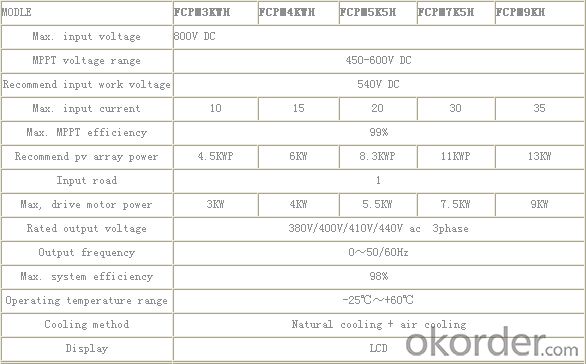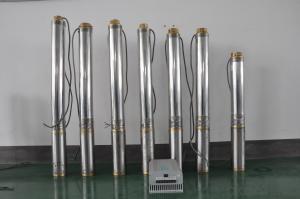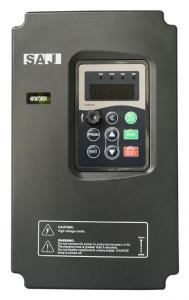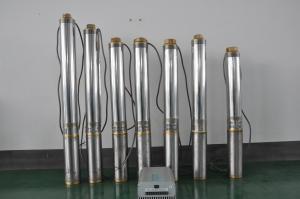Solar pump inverter FCPM3KWH
- Loading Port:
- China Main Port
- Payment Terms:
- TT OR LC
- Min Order Qty:
- -
- Supply Capability:
- -
OKorder Service Pledge
Quality Product, Order Online Tracking, Timely Delivery
OKorder Financial Service
Credit Rating, Credit Services, Credit Purchasing
You Might Also Like
Solar pump inverter FCPM3KWH Product Description:
Product Description:
Solar water pumping system is constructed with solar panel array,solar pump inverter and AC water pump, DC current produced from solar panel will be delivered to solar pump inverter,and it will convert it into AC current to drive water pump,and will automatically regulate output frequency according to sun radiance intensity,maximally realize MPPT tracking function.
Product Features
Adopting the proposed dynamic VI maximum power point tracking (MPPT) control method, with fast response, and reliable operation, achieves efficiency of 99%.
Designed with variable frequency driver, greatly improves efficiency
Extremely high efficiency
Digital mode control, with automatic operation and manual operation mode options
Complete protection functions
Adopts intelligent IPM module, with high reliability
LCD display and operation panel, in real time presents operating data
Optional for water level measurement and control circuit
Applicable for general ACC pumps, like centrifugal pump, piston pump etc.
Independent intellectual property; Highly effective, the redundant reliability, exempts the maintenance and the long life.
The pumps are soft started, fully protected.
No batteries are used. So better Sunlight, more water
Datasheet.

- Q:Can a solar pump be used to pump water from a river or lake?
- Yes, a solar pump can be used to pump water from a river or lake. Solar pumps are designed to utilize solar energy to power the pumping mechanism, allowing for efficient and sustainable water extraction from natural water sources such as rivers and lakes.
- Q:How does the availability of sunlight affect the performance of a solar pump?
- The availability of sunlight directly impacts the performance of a solar pump. The more sunlight that is available, the more energy the solar panels can convert into electricity. This translates to a higher flow rate and increased efficiency of the pump. Conversely, a lack of sunlight or cloudy weather can decrease the pump's performance as there is less energy available to power it.
- Q:Are there any limitations on the water pH or alkalinity that a solar pump can handle?
- Yes, there can be limitations on the water pH or alkalinity that a solar pump can handle. The specific limitations will depend on the design and materials of the solar pump. In general, most solar pumps can handle a wide range of pH levels, typically between 6.5 and 8.5. However, extremely acidic or alkaline water with pH levels outside this range may require additional treatment or special equipment to ensure the optimal performance and longevity of the solar pump. It is important to consult the manufacturer's guidelines or seek professional advice to determine the specific limitations of a particular solar pump model.
- Q:How does the size of the pumping mechanism affect the performance of a solar pump?
- The size of the pumping mechanism directly affects the performance of a solar pump. A larger pumping mechanism allows for greater water flow and pumping capacity, resulting in higher efficiency and faster water delivery. On the other hand, a smaller pumping mechanism may struggle to deliver the desired water volume and pressure, leading to decreased performance and overall effectiveness of the solar pump.
- Q:Can a solar pump be used in areas with high snowfall or ice conditions?
- Yes, a solar pump can be used in areas with high snowfall or ice conditions. While extreme weather conditions can pose challenges for solar panels, there are several ways to ensure the proper functioning of a solar pump in such areas. Firstly, the solar panels can be mounted at an angle to allow snow to slide off easily. Additionally, anti-icing coatings or heating elements can be incorporated into the panels to prevent the build-up of ice. Furthermore, the pump system can be designed with freeze protection mechanisms such as insulation and heat tracing to prevent freezing of the water or pipes. By implementing these measures, solar pumps can effectively operate in areas with high snowfall or ice conditions, providing a reliable and sustainable water pumping solution.
- Q:Can a solar pump be used to create a water fountain?
- Yes, a solar pump can definitely be used to create a water fountain. Solar pumps are designed to operate with solar energy, which means they can be placed in areas without access to electricity. By connecting the solar pump to a water source, it can circulate and push the water through a fountain nozzle, creating a beautiful water fountain. This makes solar pumps a sustainable and eco-friendly option for creating water features.
- Q:What is the expected lifespan of the inverter used in a solar pump system?
- The expected lifespan of an inverter used in a solar pump system can vary depending on several factors such as the quality of the inverter, the maintenance practices, and the operating conditions. However, on average, a well-maintained and good-quality inverter can have a lifespan ranging from 10 to 15 years.
- Q:How does the angle of the solar panel affect the performance of a solar pump?
- The angle of the solar panel significantly affects the performance of a solar pump. The optimal angle is determined by the geographical location and the time of year. When the solar panel is inclined at the correct angle, it maximizes the exposure to sunlight, resulting in increased energy generation and efficiency for the solar pump.
- Q:Can a solar pump be used in areas with high temperature fluctuations?
- Indeed, areas experiencing high temperature fluctuations are suitable for the utilization of solar pumps. These pumps are specifically engineered to endure a broad spectrum of temperatures, encompassing even substantial fluctuations in high temperatures. The constituent parts of a solar pump, including the solar panels, controller, and motor, are meticulously constructed to function with utmost efficiency amidst diverse temperature conditions. Nevertheless, it is crucial to guarantee the proper installation and maintenance of the solar pump in order to extend its longevity in such areas. Regular examination and cleansing of the solar panels and other components will contribute to maximizing the pump's performance and durability.
- Q:How does a solar pump handle water pressure regulation?
- A solar pump handles water pressure regulation through the use of a controller or regulator. The controller monitors and adjusts the power output of the solar panels to control the speed of the pump, thereby regulating the water pressure. This ensures that the pump operates at an optimal pressure level, preventing damage to the system and allowing for efficient water supply.
1. Manufacturer Overview |
|
|---|---|
| Location | |
| Year Established | |
| Annual Output Value | |
| Main Markets | |
| Company Certifications | |
2. Manufacturer Certificates |
|
|---|---|
| a) Certification Name | |
| Range | |
| Reference | |
| Validity Period | |
3. Manufacturer Capability |
|
|---|---|
| a)Trade Capacity | |
| Nearest Port | |
| Export Percentage | |
| No.of Employees in Trade Department | |
| Language Spoken: | |
| b)Factory Information | |
| Factory Size: | |
| No. of Production Lines | |
| Contract Manufacturing | |
| Product Price Range | |
Send your message to us
Solar pump inverter FCPM3KWH
- Loading Port:
- China Main Port
- Payment Terms:
- TT OR LC
- Min Order Qty:
- -
- Supply Capability:
- -
OKorder Service Pledge
Quality Product, Order Online Tracking, Timely Delivery
OKorder Financial Service
Credit Rating, Credit Services, Credit Purchasing
Similar products
New products
Hot products
Hot Searches
Related keywords



























